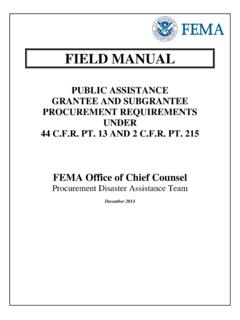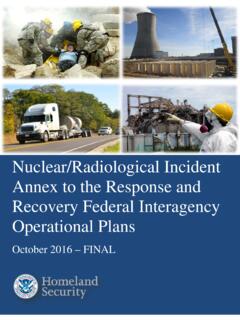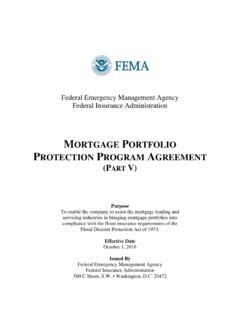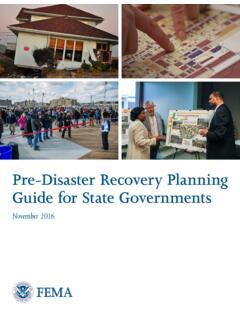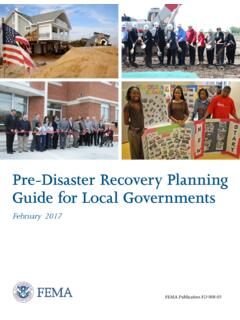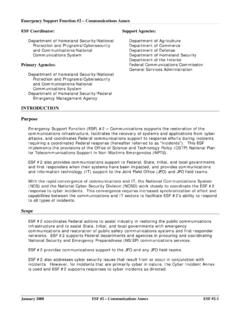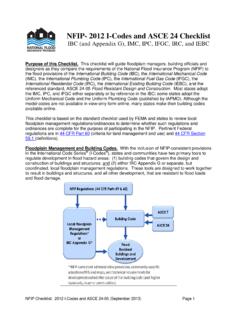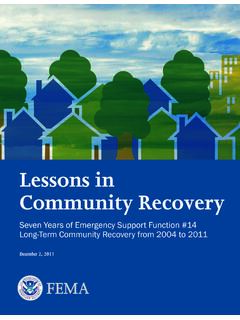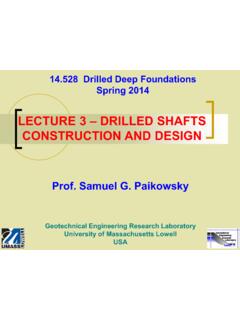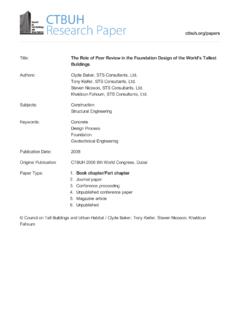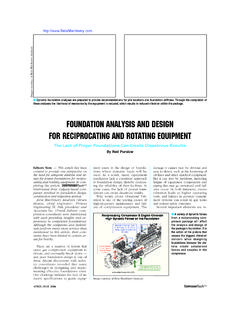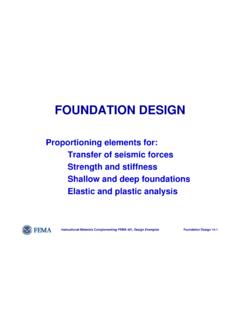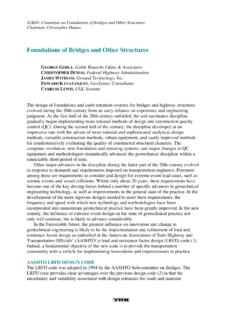Transcription of 2. Foundations - FEMA.gov
1 R E C O M M E N D E D R E S I D E N T I A L C O N S T R U C T I O N F O R C O A S TA L A R E A S2- 2. FoundationsThis chapter discusses the primary issues related to designing Foundations for residential buildings in coastal areas: foundation design criteria, National Flood Insurance Program (NFIP) requirements on coastal construction in A and V zones, the performance of various foundation types, and foundation Foundation design Criteria Foundations in coastal areas should be designed in accordance with the 2006 or 2009 edition of the IBC or IRC; both contain up-to-date wind provisions and are consistent with NFIP flood provisions. In addition, any locally adopted building ordinances must be addressed. Founda-tions should be designed and constructed to: n Properly support the elevated home and resist all loads expected to be imposed on the home and its foundation during a design event n Prevent flotation, collapse, or lateral movement of the building 2-2 Building on strong and safe foundations2 foundationsn Function after being exposed to the anticipated levels of erosion and scour that may occur over the life of the addition, the foundation should be constructed with flood-resistant materials below the Base Flood Elevation (BFE).
2 Foundation design in Coastal AreasBuilding in a coastal environment is different from building in an inland area because:n Storm surge, wave action, and erosion in coastal areas make coastal flooding more damag-ing than inland design wind speeds are higher in coastal areas and thus require buildings and their founda-tions to be able to resist higher wind in coastal areas must be constructed such that the top of the lowest floor (in A zones) or the bottom of the lowest horizontal structural members (in V zones) of the buildings are elevated above the BFE, while withstanding flood forces, high winds, erosion and scour, and floodborne debris. Deeply embedded pile or other open Foundations are required for V zones because they allow waves and floodwaters to pass beneath elevated buildings.
3 Because of the increased flood, wave, floodborne debris, and erosion hazards in V zones, NFIP design and construction requirements are more stringent in V zones than in A coastal areas mapped as A zones may also be subject to damaging waves and erosion (re-ferred to as Coastal A zones ). A Coastal A zone is also known as the Limit of Moderate Wave Ac-tion (LiMWA), which is the landward extent of coastal areas designated Zone AE where waves higher than .5 feet can exist during a design flood. Buildings in these areas that are construct-ed to minimum NFIP A zone requirements may sustain major damage or be destroyed during the base flood. It is strongly recommended that buildings in A zones subject to breaking waves and erosion be designed and constructed with V zone type Foundations (Figure 2- ).
4 Open Foundations are often recom-mended instead of solid wall, crawlspace, slab, or shallow Foundations , which can restrict floodwa-ters and be undermined easily. Figure 2-2 shows examples of building failures due to erosion and scour under a slab-on-grade foundation. NFIP Minimum Elevation Requirements for New construction *A zone: Elevate top of lowest floor to or above BFE V zone: Elevate bottom of lowest hori-zontal structural member supporting the lowest floor to or above BFE In both V and A zones, many property owners have decided to elevate one full story above grade, even if not required, to allow below-building parking. Fact Sheet No. 2 of fema 499 contains in-formation about NFIP requirements and recommended best practices in A and V zones (see Appendix F).
5 * For floodplain management purposes, new construction means structures for which the start of construction began on or after the effective date of the floodplain management regulation adopted by a community. Substantial improvements, repairs of substantial damage, and some enclosures must meet most of the same requirements as new R E C O M M E N D E D R E S I D E N T I A L C O N S T R U C T I O N F O R C O A S TA L A R E A Sfoundations 2 Figure 2-1. Recommended open foundation practice for buildings in A zones, Coastal A zones, and V zones. SourcE: COastal COnstruCti On manual ( fema 55)Figure 2-2. Slab-on-grade foundation failure due to erosion and scour undermining and closeup of the foundation failure from Hurricane Dennis, 2005 (Navarre Beach, Florida).
6 SourcE: HurrIcANE DENNIS MAT PHoTo 2- Building on strong and safe foundations2 Foundation Styles in Coastal AreasSeveral styles of Foundations can be used to elevate homes. In discussing foundation styles, it is beneficial to categorize them as open, closed, shallow, or deep. As the name implies, open Foundations generally consist of piles, piers, or columns and present minimal obstructions to moving floodwaters. With open Foundations , moving flood-waters, breaking waves, and smaller pieces of floodborne debris should meet relatively few obstructions and hopefully be able to pass under the home without imparting large flood loads on the foundation. Open Foundations have the added benefit of disrupting flood flows less than larger obstructions.
7 This can help to reduce scour around foundation the other hand, closed Foundations typically consist of continuous foundation walls (con-structed of masonry, concrete, or treated wood) that can enclose crawlspaces or, as in the case of stem walls, areas of retained soils. Closed foundation walls create large obstructions to mov-ing floodwaters and large flood forces can be imparted on them by breaking waves, floodborne debris, and the hydrodynamic loads associated with moving water. Closed Foundations are also more vulnerable to scour than open terms shallow and deep signify the relative depth of the soils on which the homes are founded. Shallow Foundations are set on soils that are relatively close to the surface of the surrounding grade, generally within feet of the finished grade.
8 In cold climates, shallow foun-dations may need to be extended feet or more below grade to set the foundation beneath the design frost depth. Shallow Foundations can consist of discrete concrete pad footings, strip foot-ings, or a matrix of strip footings placed to create a mat foundation. Mat Foundations have the added benefit of better resisting uplift and overturning forces than Foundations consisting of discrete pad Foundations are designed to be supported on much deeper soils or rock. These founda-tions frequently are used where soils near the surface have relatively weak bearing capacities (typically 700 pounds per square foot [psf] or less), when soils near the surface contain expan-sive clays (also called shrink/swell soils because they shrink when dry and swell when wet) or where surface soils are vulnerable to being removed by erosion or typical foundation styles vary geographically, deep Foundations for residential con-struction in coastal areas generally consist of driven treated timber piles or treated square piles.
9 Driven concrete piles are common in other areas. Only open Foundations with base members or elements (piles or beams) located below expect-ed erosion and scour are allowed in V zones; as a best practices approach, open Foundations are recommended, but are not NFIP required, in Coastal A zones. Table 2- shows the recom-mended type of foundation depending on the coastal area. Additional information concerning foundation performance in coastal areas can be found in fema 99, Fact Sheet No. (see Ap-pendix F).2-5R E C O M M E N D E D R E S I D E N T I A L C O N S T R U C T I O N F O R C O A S TA L A R E A Sfoundations 2 Table 2-1. Foundation Type Dependent on Coastal AreaFoundation TypeV ZoneCoastal A ZoneA ZoneOpen444 Closed8NR44 = Acceptable NR = Not recommended 8 = Not Open FoundationsOpen Foundations are required in V zones and recommended in Coastal A zones.
10 As previously mentioned, this type of foundation allows water to pass beneath an elevated building through the foundation and reduces lateral flood loads on the structure. Open Foundations also have the added benefit of being less susceptible to damage from floodborne debris because debris is less likely to be trapped. PilesPile Foundations consist of deeply placed vertical piles installed under the elevated structure. The piles support the elevated structure by remaining solidly placed in the soil. Because pile Foundations are set deeply, they are inherently more tolerant to erosion and scour. Piles rely pri-marily on the friction forces that develop between the pile and the surrounding soils (to resist gravity and uplift forces) and the compressive strength of the soils (to resist lateral movement).

